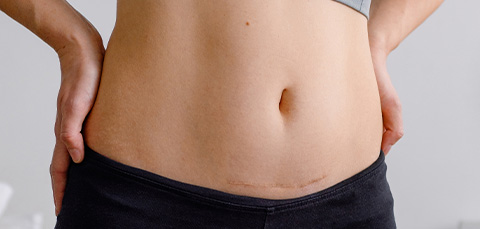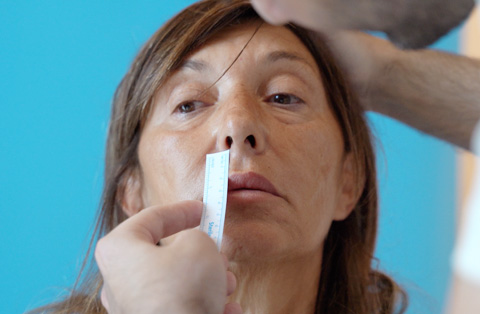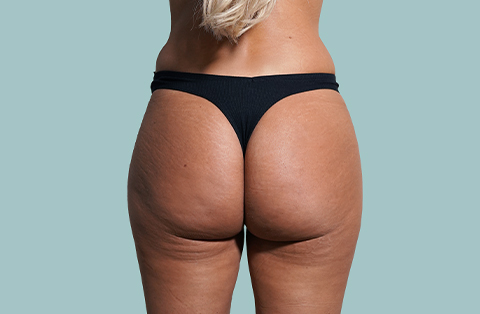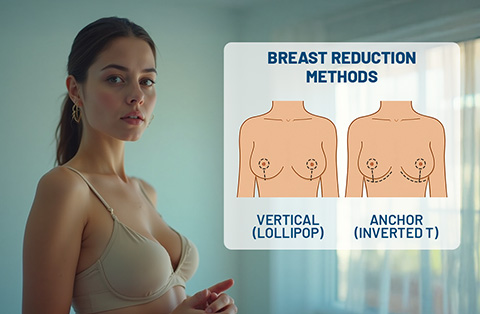If you've undergone a tummy tuck and are concerned about the visibility or discomfort of your scars, you're not alone. Many individuals find that post-surgical scars can detract from the aesthetic benefits of a tummy tuck surgery.
This article delves into the types of scars associated with tummy tuck procedures, explores the healing process, and outlines effective strategies for scar management and revision.
Whether you're considering options to enhance the appearance of your scars or simply seeking a better understanding of what to expect during recovery, we're here to provide comprehensive insights and solutions to improve your post-operative results.
What is a tummy tuck scar?
A tummy tuck scar results from an abdominoplasty, a surgical procedure aimed at creating a firmer, flatter abdomen. This scar typically runs horizontally across the lower abdomen, just above the pubic area. Its length and appearance depend on the extent of the surgery and the specific techniques used by the surgeon.
While the scar is a necessary outcome due to the incisions required to remove excess skin and fat and tighten abdominal muscles, its visibility can vary. Proper post-operative care and following your surgeon's guidelines can significantly influence the scar's healing and final appearance, making it less noticeable over time.
Tummy Tuck Scar Types
Tummy tuck procedures can result in various types of scars, each characterized by its location and the specific tummy tuck technique used.
The most common scar is the horizontal line that stretches between the hips, just above the pubic area, which arises from standard abdominoplasty.
Mini-tummy tucks usually lead to shorter scars, while extended or circumferential tummy tucks result in longer and more prominent scarring that may wrap around the hips to the lower back.
The appearance and severity of these scars can differ based on surgical methods, the body's healing response, and post-operative care.
Types of Abdominoplasty Scars:
Horizontal Scar: Typical of full tummy tuck.
Mini Tummy Tuck Scar: Shorter and located lower in the pubic area.
Extended Tummy Tuck Scar: Runs longer, extending beyond the hips.
Circumferential Tummy Tuck Scar: Encircles the body, including the back.
Vertical Scar: Occasionally used for removing excess skin vertically.
Dog Ear Issue After Tummy Tuck Revision
The "dog ear" issue in tummy tuck procedures refers to puckered skin that can form at the ends of the surgical scar. These bulges occur when the skin is unevenly tightened during closure, resulting in a gathered or bunched appearance.
Dog ears can detract from the smooth contour of a tummy tuck, but they are correctable through additional minor surgery that smooths out the affected areas for a more natural finish.
What is Tummy Tuck Scar Revision Surgery?
Tummy tuck scar revision surgery is a procedure designed to improve the appearance of scars resulting from a previous abdominoplasty. This surgery aims to make the scars less noticeable by altering their width, length, or thickness. Surgeons may reposition the scar, reduce its prominence, or enhance the overall aesthetic by creating a more natural skin contour.
The process typically involves removing or reorienting the scar tissue and carefully suturing the new incision to promote finer, less visible scarring. Scar revision can significantly boost a patient's confidence and satisfaction with their tummy tuck results.
Scar Revision Procedure
Tummy tuck scar revision surgery is a specialized procedure aimed at improving the appearance of scars left from an initial abdominoplasty. The surgery follows these steps:
Consultation: The surgeon evaluates the existing scar, discusses expectations, and plans the approach.
Anesthesia: Administered to ensure patient comfort during the procedure.
Incision: The surgeon makes a precise cut along the existing scar.
Removal of Scar Tissue: Excess or problematic scar tissue is carefully removed.
Repositioning: Skin around the scar is gently repositioned to lie more smoothly.
Closure: The new incision is closed with fine sutures to minimize future scarring.
Recovery: The area is bandaged, and post-operative care instructions are provided to support healing.
This process aims to reduce the visibility of the scar, leading to a more aesthetically pleasing abdominal appearance.
Other Treatments for Tummy Tuck Scars
Besides surgical revision, several other treatments can help improve the appearance of tummy tuck scars. These treatments enhance skin texture and reduce scar visibility:
Silicone Gel Sheets: Applied directly to the scar, these sheets help flatten and soften the tissue.
Steroid Injections: Reduce scar thickness and alleviate itchiness or discomfort.
Laser Therapy: Uses focused light to diminish redness and improve skin smoothness.
Microneedling: Promotes collagen production to help the skin heal more aesthetically.
Cryotherapy: Involves freezing the upper skin layers, leading to tissue removal.
Topical Creams: Contain ingredients like vitamin E and onion extract that can help reduce scar visibility.
These methods can be effective alternatives or complements to surgical intervention, offering non-invasive ways to handle scar management.
How Much Does Tummy Tuck Scar Revision Cost?
The cost of tummy tuck scar revision varies depending on the complexity of the procedure, the surgeon's expertise, and geographic location. Factors influencing the price include the length and severity of the scar and the specific treatment method used, such as surgical revision, laser therapy, or injections.
Comparison Chart of Tummy Tuck Scar Revision Cost:
Country | Average Cost (in Euros) |
Turkey | €1,000 - €2,500 |
UK | €2,500 - €4,500 |
France | €2,000 - €3,500 |
Germany | €2,500 - €4,000 |
USA | €3,000 - €5,000 |
These estimates reflect the variety of techniques available for scar revision and should be verified with specific clinics for more precise pricing.
Tummy Tuck Scar Revision Before After
Before and after photos of tummy tuck scar revisions clearly illustrate the improvements that can be achieved. These cases highlight the changes from visible, often prominent scars to much subtler, smoother lines. Viewing such comparisons can provide a realistic expectation of the potential enhancements and the effectiveness of different revision techniques.
Explore our Before after gallery to see the transformative effects of tummy tuck scar revision surgeries.
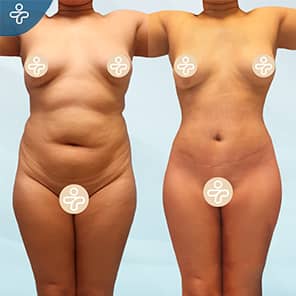
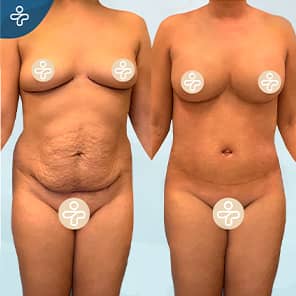
Tummy Tuck Turkey Before and After Photo Gallery. Click for more >>
Risks and Complications
Tummy tuck scar revision carries certain risks and complications, similar to any surgical procedure. These include:
Infection: Can occur at the incision site.
Bleeding: Potential for excessive bleeding during or after surgery.
Scarring: While the goal is to reduce scar appearance, surgery can sometimes create new scars.
Allergic Reactions: To anesthesia or other materials used during surgery.
Poor Healing: Leading to uneven skin texture or discoloration.
Discussing these risks with your surgeon before proceeding is crucial to make an informed decision.
Frequently Asked Questions
How can I minimize scarring as my tummy tuck incisions heal?
To minimize scarring as your tummy tuck incisions heal, follow these tips: keep the incision area clean, apply silicone gel sheets or scar cream as recommended, avoid direct sunlight on the scar, and follow all post-operative instructions provided by your surgeon.
Can steroid injections treat a tummy tuck scar?
Yes, steroid injections can treat a tummy tuck scar. They help reduce scar thickness and relieve itchiness or discomfort. Typically, a doctor administers these injections over several sessions to achieve the best results. Always consult with your surgeon to see if they are suitable for you.
Can laser skin resurfacing treatments treat a tummy tuck scar?
Yes, laser skin resurfacing treatments can treat a tummy tuck scar. These treatments work by removing layers of skin around the scar to stimulate new, smoother skin growth. Consult with a dermatologist or plastic surgeon to determine if this option is right for your specific scar type.
Can scar revision surgery treat a tummy tuck scar?
Yes, scar revision surgery is the most effective tummy tuck scar treatment. This procedure aims to improve the appearance of the scar by reducing its size or changing its position. It's important to consult with a qualified plastic surgeon to discuss the best approach for your situation.
Is scar revision surgery worth it?
Scar revision surgery can be worth it if you are concerned about the appearance of your scars. It can enhance the look and feel of the skin, boosting self-confidence. Discussing expectations with a qualified surgeon helps ensure the benefits outweigh the risks and costs involved.
Can tummy tuck scar be lowered?
Yes, a tummy tuck scar can often be lowered through revision surgery. This procedure adjusts the position of the scar to make it less visible, typically placing it lower so it can be more easily concealed by underwear or swimwear. Consult a skilled surgeon for details.
